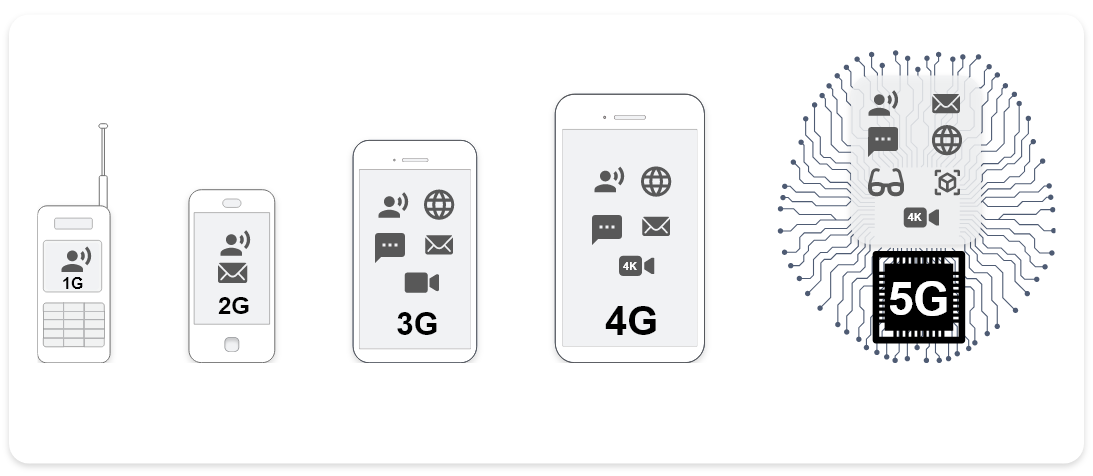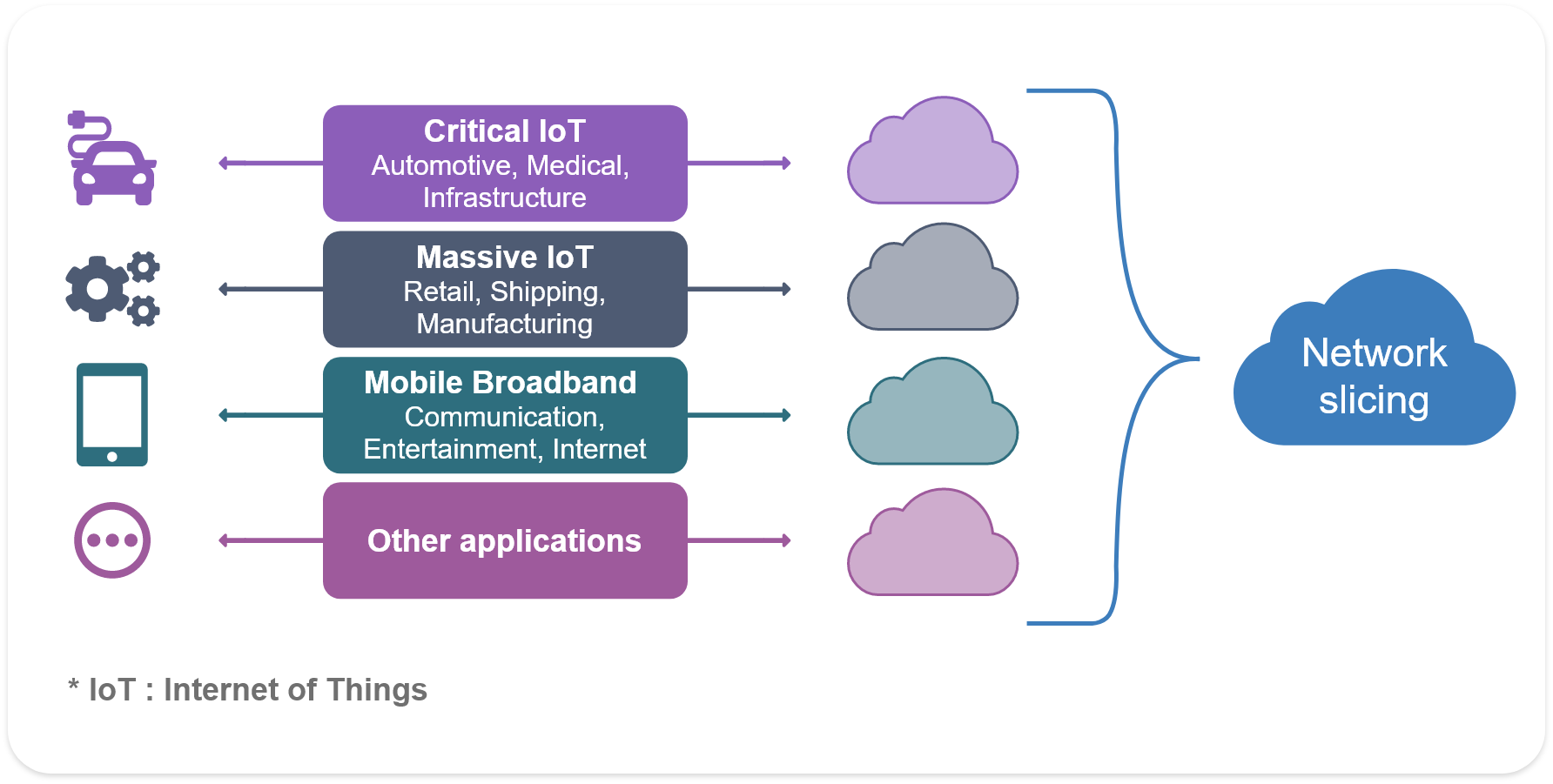5G Explained
Today's world is fuelled by connectivity. From telemedicine to telework, to accessing public services and keeping in touch with friends and family, almost everything we need to live easier, healthier and safer lives depends on our access to a reliable high-speed internet connection. Introducing the 5G era!
What is 5G and how does it differ from previous networks?

Preceded by 1G, 2G, 3G and 4G, 5G is the fifth generation of cellular networks. Since 2019, 5G has started transforming how people live, work and play.
- 1G: Provided analog voice transmission through electrical signals in the 1980s.
- 2G: Introduced digital voice, SMS (texting) and MMS (video, image, and audio) in the 1990s.
- 3G: Allowed Blackberry and iPhone devices to use mobile data and browse the internet in the early 2000s.
- 4G: 4G LTE was introduced in the 2010s; it made phones and mobile apps function more rapidly and smoothly and allowed users to stream videos.
The latest generation, 5G was designed to be faster, with less delay, and capable of handling more data than previous generations and allowing more devices to connect and communicate efficiently, making it ideal for applications such as the Internet of Things (IoT).
How does it work?

Spectrum bands play an important role in how 5G operates. Spectrum refers to the range of radio frequencies that signals use to travel through the air. It is what allows us to make phone calls, use social media, get directions, and use various applications on our mobile devices. The spectrum is generally divided into three types: low-band, mid-band and high-band.
Like 4G LTE, 5G uses less crowded, higher frequency bands to send more information, faster. The higher frequency bands are called millimetre waves (mmWaves) and allow for faster speed and lower latency by reducing the amount of time it takes for a device to communicate with the network.
To access the internet, send or receive data, make phone calls, or connect to other devices on the same network, your phone must communicate with the network. The network facilitates the connection between your device and other devices. Let's say you want to stream a video on your phone: You open your app and select the video you want to watch, and your device communicates with the network to make the request. The network then requests the video data from the server and relays it back to you.
However, when it comes to travelling long distances, mmWaves do not travel well across obstacles such as trees and buildings. To overcome these challenges, 5G uses multiple antennas called nodes to boost signals and improve network capacity.
Instead of relying on large towers, 5G uses nodes placed on buildings, streetlights and power lines. This setup is designed to accommodate a much larger number of devices simultaneously, allowing for more connections without experiencing any lag or slowdown. In addition, 5G can split a physical network into multiple virtual networks, known as network slices, allowing network operators to provide the best network slice based on usage requirements.
For example, someone watching a video would use a different slice than a business, while simpler devices can be separated from more demanding tasks, like controlling self-driving cars. Network slicing allows network operators to better manage their networks and deliver the best performance based on individual requirements.
What does 5G offer?

- Faster internet speeds: With 5G, you can download a movie in seconds rather than minutes.
- More reliable connections: 5G's lower latency means that video calls, online games and other real-time applications are more stable and responsive.
- New applications: 5G enables new applications, such as sensors, remote surgery, autonomous vehicles and smart cities.
- More efficient networks: 5G's ability to connect more devices simultaneously can reduce the strain on existing networks and improve overall efficiency.
What are some of the concerns with 5G?
- Privacy: The rapid expansion of 5G networks raises privacy concerns due to the large amount of data being transmitted. Having multiple connected devices, especially without proper security measures, could provide more entry points for hackers to access personal information. There is also a concern about potentially obtaining software and hardware components for 5G infrastructure from unreliable sources, which could compromise data security.
- Cyber security: 5G networks pose cyber security risks due to the extensive use of connected devices and the large volume of generated data. However, these risks are not limited to 5G but apply to network security in general. Hackers could exploit vulnerabilities, potentially disrupting the existing 4G LTE infrastructure; the increased data traffic on 5G networks could make it challenging to monitor and detect security threats.
- Digital divide: The deployment of 5G networks could worsen the existing digital divide, with some areas or communities having limited access to high-speed internet or lacking the necessary infrastructure for 5G connectivity. This can further marginalize underserved areas and limit equal opportunity for everyone.
- Infrastructure and cost: 5G requires extensive upgrades to the infrastructure, which can be quite expensive to build and maintain. As a result, network operators pass along their increased expenses to consumers in the form of higher prices.
- Compatible devices: Currently, not everyone can reap the benefits of 5G networks because their device may not support 5G.
How is the government involved with 5G?
The Government of Canada, in line with its Digital Charter, recognizes the importance of ensuring equal access to digital opportunities for all citizens, including connectivity. It is committed to supporting this objective by making advanced wireless networks readily available. To this end, the government has allocated funding through the Strategic Innovation Fund to support the development of 5G infrastructure projects and research and development initiatives related to 5G technology.
In April 2023, in line with their vision, the Government of Canada partnered with Ericsson in a five-year, $470 million research and development partnership. This collaboration aims to position Canada as a global leader in next-generation communication technologies, including 5G Advanced, 6G, AI, Cloud RAN, and core network technologies. The investment will not only create new jobs and upskill employees but also supports the expansion of research facilities, paving the way for faster and more secure internet connections and wireless services while maintaining Canada's technological leadership.
In May 2023, the Minister of Innovation, Science, and Industry announced a new licensing policy that makes it easier for smaller internet service providers, rural, remote, and Indigenous communities to get access to 5G. Instead of competing for licences, users can now acquire spectrum that covers small areas such as a single farm, factory, university campus, or shopping centre. This increased accessibility creates new possibilities for innovation.
As mentioned earlier, spectrum refers to the range of radio frequencies. Each band has its own capacity. The low-band provides greater coverage but is somewhat slower. The mid-band offers a balance between coverage and speed. And the high-band offers higher speed but covers a smaller area.
For instance, a farm can use a low-band spectrum to create a private network for automated tasks like tracking crops or tracing products. These tasks require a lot of data and fast network speeds, which the new spectrum can provide. Even with low-band 5G, farmers have access to a faster and more reliable network than with previous wireless solutions. Additionally, allocation of spectrum will help wireless broadband providers improve connectivity across various regions in the country, especially in rural, remote and Indigenous communities.
By leveraging the range of radio frequencies, service providers can offer better internet access to people who previously had limited options, bridging the digital gap and ensuring that everyone has access to reliable wireless internet services.
The future of 5G
5G represents a remarkable leap forward in communication technology, with the potential to change industries and improve our daily lives. The enhanced speed, capacity and low latency of 5G networks offer exciting possibilities for applications such as autonomous vehicles, remote surgeries and smart cities. However, it's important to address challenges concerning privacy, security, equitable access and ethical data usage as 5G evolves.
Some food for thought
- What are the environmental, economic and societal impacts of 5G?
- How can we ensure that speed does not compromise data privacy and cyber security?
- What ethical guidelines and regulations should govern the collection, use and sharing of data on 5G networks?
Resources to dig deeper